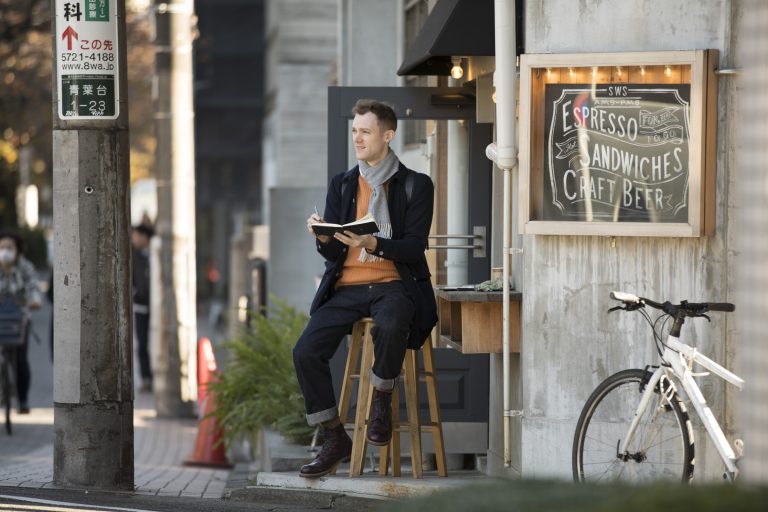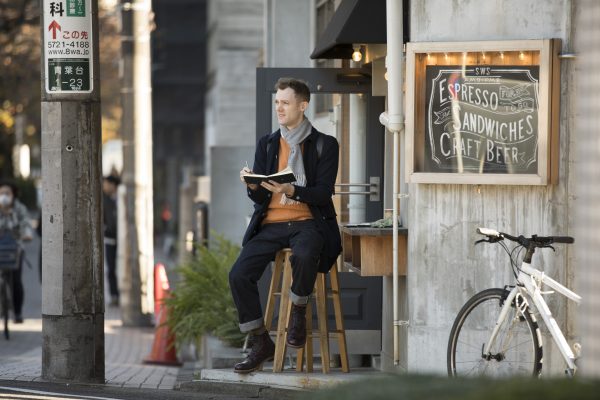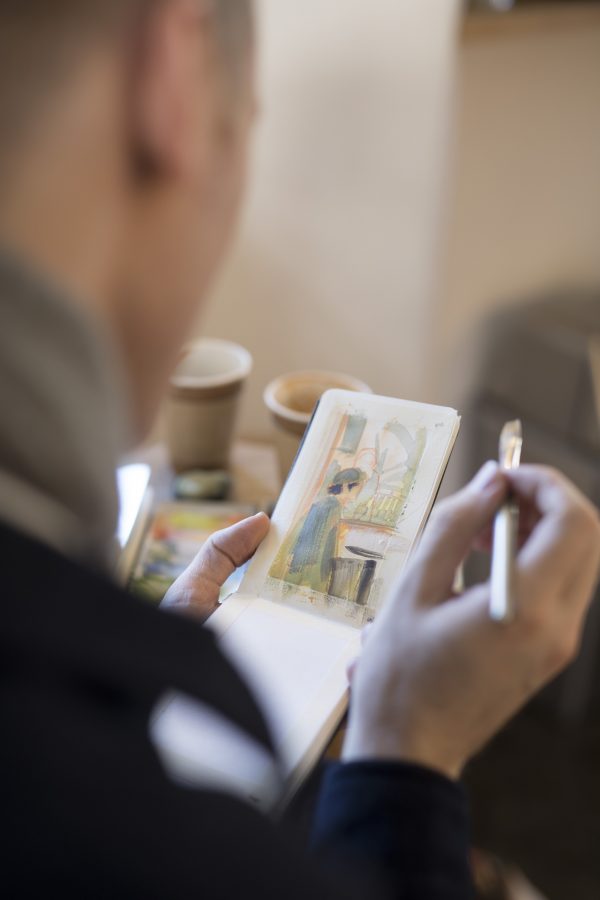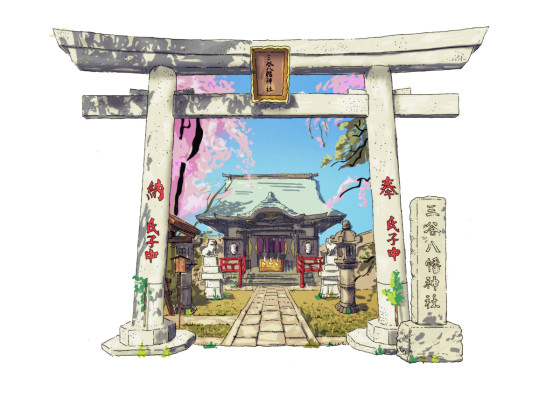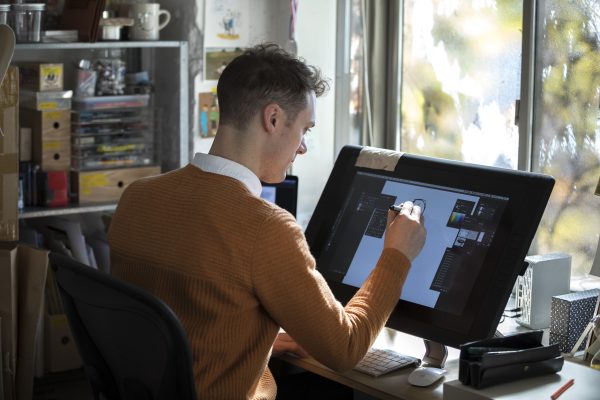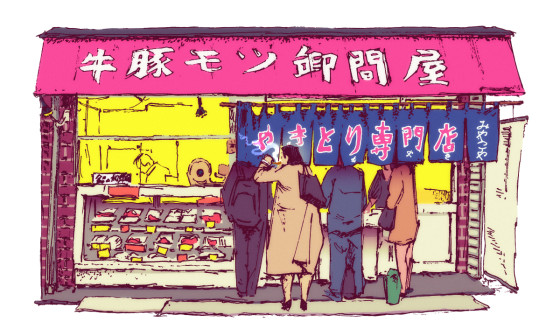From sketching in high school to illustrating for the biggest names in Japan, Adrian Hogan has become one the most recognised names on the Tokyo creative scene. Having developed a love of sketching as a student during long commutes, Adrian eventually moved to Japan to teach English and found a world of inspiration.
Settling in Tokyo in 2013, his career has grown and he works with brands like Popeye, Starbucks and Fujifilm while continuing to sketch the everyday scenes that inspired his move. Adrian is no reclusive artist though; with presentations at PechaKucha, co-founding community group PauseDraw and going viral with coffee cup scenes of the city, he’s paid the inspiration forward.
Have you always been a keen sketcher or did you find a love for it while in Japan?
I have been keeping a sketchbook and drawing in it almost everyday since I was in high school. At that time, I had an hour-long train commute to school and would use the time to draw the other passengers. It became an addictive habit very quickly and has led to a life-long passion. Japan is full of inspiration and there’s no shortage of things to draw, so I take my sketchbook out with me wherever I go. I have lived in Tokyo for awhile now so my sketchbook is an important way to help me see the city with fresh eyes.
What made you come back to Japan?
I love Japanese magazines and design and I also wanted to learn more about Japanese illustration. In order to start a career here, I felt it was necessary to make the move over in order to develop relationships. Australians in the creative arts tend to move to New York or London at some stage of their career. However for me, it’s important that we get to know more about the region we live in and understand one another. The skill set to thrive in Tokyo is different to the one you would need in a place like New York.
You tend to use watercolours for your work—what is it about them that suits your sketches?
Recently I have been really interested in the colours you can see in Tokyo. Using watercolour and gouache allows me to train my eye to be sensitive to colour and try and record them. These colour notes can sometimes make their way into my illustration work or a personal project. Watercolour and gouache are also really fast mediums to use and are a fun break away from my digital computer work. There’s no “cmd + Z”, so you train yourself to make confident marks.
In terms of colour, I have been inspired by the ginkgo leaves trees changing colour in autumn, the recent grey-blue snowy weather we recently experienced in Tokyo and the bright lights of Shibuya at night.
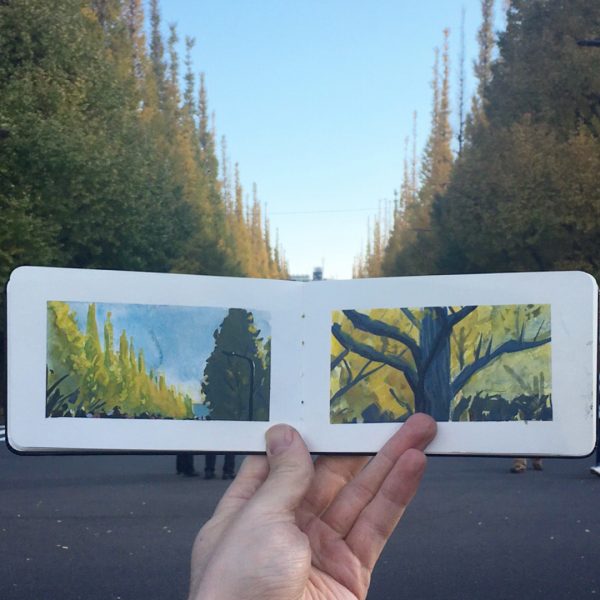
A lot of your sketches are of people doing everyday things in Tokyo, like riding the train or working. Has anyone noticed you sketching them or asked to see your work?
Absolutely—I have made some of my best friends through drawing. There are so many people who want to draw but are intimidated doing it on their own, which is why my friend Luis Mendo and I started PauseDraw where all ages and abilities come together and draw. When you’re drawing in a group, you inevitably start to loosen up and focus on having fun rather than making perfect or finished pieces. We think that when people are less self-aware, they achieve better results with their drawing and will surprise themselves.
I have also learned that, sometimes, just by blindly doing the thing you love and then sharing it with others, the opportunities you want will present themselves to you. A lot of my work in Tokyo initially came to me just by drawing the right people at the right time. For example, one day I was at Shibuya Station and drew a woman standing on the platform; when I got on the train she appeared beside me and asked to see it. We exchanged business cards and I learned that she was the director of PR at a popular clothing brand here. Eventually I was commissioned to draw portraits of customers at their head boutique store in Aoyama during Vogue’s Fashion Night Out event in 2014. I have also met some of my closest friends in Japan while drawing and being able to meet and share our passion has encouraged me to keep going.
Your coffee cup art gained a lot of attention across the media, did you expect that level of attention? Also, why do you think it was so popular?
When I made the first video I sensed that it would be a popular post, though I had no clue that it would go viral the way it did. A magazine called Mascontext, who I had drawn a cover illustration for, kindly forwarded my work to Colossal—and it all went from there. I think the videos brought a lot of different elements together—art, drawing, japan and coffee—but they also remind people that anything can be used for art and that those paper cups we all throw away can be given new value and made precious.
PechaKucha is one of our favourite creative events, how did it feel to be a part of something like that?
PechaKucha is a fantastic event. Astrid and Mark are great ambassadors for the creative community in Tokyo and it is an honour to be asked to make a contribution when I can. My first presentations really assisted in introducing myself to the city so I always recommend attending if you are new to Tokyo.
In your presentation, you talk about how sketching is your hobby, but illustration is your job—how did you move from one to the other, and what makes you continue sketching?
I am at a stage where I am able to support myself from drawing lines on paper everyday but it has taken over 10 years of daily practice to get here. I do it because I love to draw, but also because it is an ingrained and essential part of my daily routine.
Money is not a popular topic for creatives to talk about, especially artists, but I feel that I have to make the distinction really, really clear because drawing as a hobby is different to drawing as a commercial artist. Lots of people love to draw but, there’s a whole suite of other skills that you have to develop to be a commercial artist. Fortunately, like drawing and the Japanese language, business and accounting skills are perfectly learn-able skills too.
Many people consider drawing to be a solitary activity, but you started PauseDraw and go out with friends to draw together—what do you think this brings to the table?
PauseDraw is a public, free event that fellow illustrator Luis Mendo and I do one Sunday every month. We invite people of all ages to come and draw. We do it because we love drawing and drawing has given us a lot of happiness, so we try to share it with as many people as possible. It’s a little bit like the Big Draw but we do it more regularly and with the emphasis of being a place to meet other creatives. You are all welcome to come and join, check our PauseDraw events page.
Drawing does require an element of introspection but in a group you are able to loosen up and learn from others. It’s always fun to see how other people can approach the same subject and materials and respond in different ways. Tokyo can be an expensive city but all you need to have a good time is a pen and paper.
Your work moved from the food on your plate to the spaces you were in and then Tokyo itself—has drawing impacted your view of Tokyo or has Tokyo impacted your drawing more would you say?
From the materials I use (Japanese brushes, pen nibs, etc.) through to the visual shorthands and motifs I’ve developed, I’d say that both have informed the other. Tokyo has some amazing infrastructure and communities and inspiration to draw while drawing the city helps me to be present, observe and notice details.
Visually, Tokyo appears flat, textural and grey with bright splashes of colour, and my drawings have started to incorporate some of these elements. Tokyo itself is a lot like a drawing in that there are all kinds of lines everywhere, in the street signs, and markings, the electric power lines that overhang the streets, and the tiles and textures.
What are your favourite aspects of Japan/Japanese culture to draw?
All of it. There are so many entry points. The cuisine, clothing, manners, design, buildings, cultural interactions, people—it’s endless. But that’s the thing about drawing. Drawing through observation allows you to open yourself up to whats really in front of you and not make any assumptions or stereotypes. That said, my approach to drawing is very influenced by Western methods so it is an interesting challenge to apply them to a different environment while also being open to new discoveries.
You’ve had so many impressive clients, which projects have been your favourite?
It’s hard to pick. It’s exciting when a new client gives you call, but it’s still a thrill when an existing client loves what you do and continues to work with you over a longer relationship. Some of my favourite projects include art directing with Tomorrowland for their Spring/Summer campaign, 30-metre long murals, traveling around the country as a reportage artist and working for the various magazines that made me become interested in Japanese art and design in the first place.
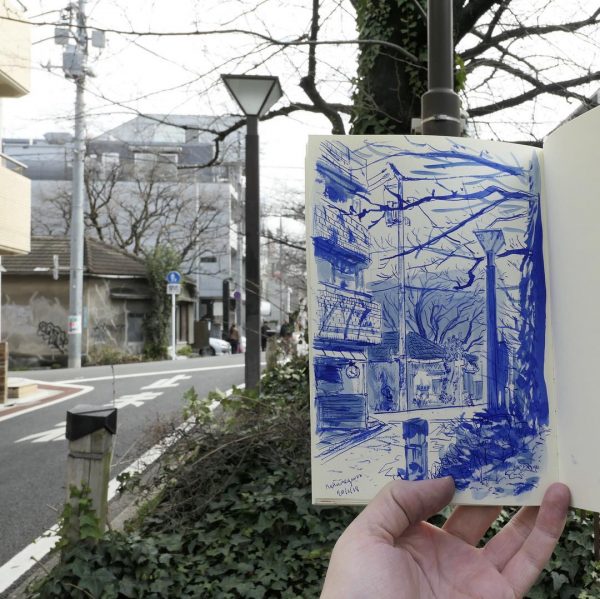
Did you ever see yourself being a full-time illustrator living in Tokyo? Do you think you’ll stay, or are there other countries you would like to explore through your work?
When I started drawing in those early sketch books, I didn’t imagine that it could lead to a career in Japan—but I have always felt that anything is possible if you set your mind to it and are relentless about pursuing your dreams. It was not a direct trajectory from school to full-time, independent work but I have been fortunate to have been encouraged to follow my interests and that has led to all manner of interesting and rewarding experiences along the way.
To see more of Adrian’s work, follow him on Instagram.

